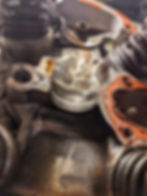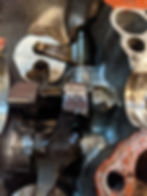XR650L Oil Pump Air Entrapment
- rcl5011
- Nov 23, 2021
- 7 min read
Updated: Jul 13, 2023
An investigation into how and why oil starvation can occur on XR650L and XR600R engines.
Wet Sump vs Dry Sump
Oil is meant to maintain a slippery hydraulic barrier between sliding and rotating components inside of an engine. Oil is distributed to critical locations by way of an oil pump. There are two primary lubrication designs for engines. One being a wet sump design and the other being a dry sump design. Wet sump engines store their oil in the bottom of the engine and rely to a large degree on splash lubrication of the crank and transmission. Dry sump engines on the other hand store oil in a remote reservoir and pump oil to targeted locations. The XR650L and XR600R engines utilize a dry sump design. Their oil reservoir is located in the upper and front most portion of the motorcycle frame. This provides two main benefits; cooling, and reduction of parasitic losses (loss of power resulting from rotating engine parts being slung through viscous liquid). This means that the function of the oil pump on these engines is critical.
XR Engine Lubrication Design
The service manuals for these engines provide a good diagram showing the oil flow pathways throughout the engine, and are worth studying if you're interested in this topic. Below is an example of the oil flow for the XR650L engine (identical to the XR600R engine in terms of oil flow)

Walking Through the Oil Flow Diagram
Oil initially gets picked up from the oil strainer screen and sent into the oil pump. The pump is split into two independent halves. The inner most half is the scavenging pump. It draws the oil from the bottom of the transmission/crankcase at a high flow rate. Once it leaves the inner half of the pump, oil is split and a portion of it gets sent directly back to the transmission (without ever going through the oil filter), and the other portion gets sent out of the bottom front of the engine case, up the steel oil line, and into the frame reservoir (just under the front of the gas tank). The oil has some time to transfer it's heat while it's up here and also eliminate some aeration that may have occurred. Eventually the oil makes its way down to the bottom of the frame, where it is filtered through a course mesh screen labeled "oil strainer nut" in the above diagram. The oil then re-enters the engine and goes back into the oil pump for the second time, but this time it gets sent to the outer half of the oil pump, where it is sent through a spring loaded check valve (incorrectly labeled in the diagram as a "relief valve"). When the check valve opens due to the oil pressure, oil flows up into the oil filter cavity. From the oil filter cavity, oil enters the oil filter body, and is at this point split. Some of the oil flows back down to the crank shaft to lubricate the rod bearings, while the rest of the oil flows up to the cylinder head to lubricate the cam and rockers.
How Oil Starvation Can Occur
There are many factors that can contribute to oil starvation in these engines. Failure to install o-rings between the right side engine cover and oil pump (or installing damaged ones) is a common source. Others include pinched oil lines from a crash, loose banjo bolt connections, oil consumption contributing to low oil levels, or failure to purge the oil pump of air after disassembling/reassembling, or air becoming entrapped in the pump during a crash. These last two conditions describing air entrapment are what I would like to focus on in the remainder of the discussion here. Air entrapment due to a failure to purge the oil pump of air during a rebuild is a very unfortunate situation that some people forget about. The manual directly states that oil must be pre-loaded into the pump prior to assembly in order for the pump to be able to prime itself and draw in oil. The description from the Honda manual is shown below:

Note that priming is required not on the scavenging side of the pump, but on the outer side which flows through the check valve, and then to the crank and valvetrain. This means that the pump is unable to overcome the check valve when the pump is full of air. The design of the pump is such that with the combination of air being compressible, but also being extremely low viscosity compared to oil, it is able to slip past the close clearances between the rotor and housing. This means that as the pump rotates, air is just recirculated internal to the pump indefinitely, no matter the engine speed.
This air entrapment problem during an engine rebuild can be alleviated by following priming instructions above. But what happens when air enters the pump for other reasons, possibly with no forewarning or indication that it has occurred.
Air Entrapment During A Crash
As described above, the outer portion of the oil pump is unable to overcome the check valve spring force when the pump is full of air. Air in the pump is a bad situation that provides no indication that it has occurred. Going back to the oil flow diagram walkthrough from earlier in this article, you can see that the oil sits inside of the frame reservoir and is pulled into the pump at the bottom of the frame. The frame reservoir is not filled solidly with oil, but has a generous air gap at the top where the top stick is installed. Imagine for a minute that you dump your motorcycle on its side with the handlebars facing downhill, and the engine continues to run for a while, or at worst, you land on the throttle side facing downhill and the crash opens the throttle, causing the engine to run at a high speed. The air pocket that normally sits at the top of the reservoir will get inverted and sent to the bottom of the frame, just like inverting a bottle of water. This air pocket gets sucked into the pump as the last remaining amount of oil is evacuated through the check valve. The pump can no longer overcome the check valve spring force, and just sits there spinning away, not pumping any oil. Meanwhile, the scavenging pump that is pulling oil from the bottom of the engine is not constrained by the check valve, and so it pumps away the remaining oil that is available for splash lubrication, and sends it up to the reservoir. This situation will cause a full frame reservoir yet not provide any oil to the engine components. This exact situation has been documented in the past, and has occurred to our very own XR650L that we use for development purposes. A crash causing the throttle to stick open when the handlebars were down hill caused an air entrapment situation that lead to a total top end failure. The failure occurred with no prior warning. There's no way to actually know when and if this occurs without cracking your banjo bolt and verifying that you still have oil flow. Some pictures of the engine failure carnage:



Solutions
Identifying Air Entrapment
After dealing first hand with this situation, we decided to come up with a solution that would have given us positive feedback that things were not right. For this solution, a banjo bolt sight glass was designed. It was then prototyped, tested, and verified to give real-time feedback as to the state of oil flowing to the cylinder head. This product can be ordered here.

This design is compatible with XR650L, NX650, XR600R, and a few others. Being able to see oil flow in real time is invaluable.
Eliminating Oil Entrapment
In addition to being able to identify and visually see that oil is either flowing or not, we also wanted to dive into the reasoning behind why the check valve stops air from being purged and whether improvements can be made. An evaluation of the check valve and pump was done. Here's a video showing OEM check valve spring in the oil pump with a full reservoir of oil. The pump was installed dry (not primed). No matter the RPM, the pump would not purge the air pocket:
Below is a Summary of OEM Specs:
Check valve spring rate = 1.52lbf/in
Check spring compression (when valve is closed) = 0.20in
Pump Orifice ID = .276in (7mm)
Required Oil Pressure to Open Valve = 5.1psi
Relieve Valve to Pressure Head Safety Margin = 5.1psi/.5psi = 10X
In addition to the oil pump generating pressure, there is a pressure head from the column of oil sitting in the frame reservoir. This accounts for in rough numbers 0.5psi of pressure negating any pressure losses due to piping. This theoretically pre-pressurizes the pump and adds a constant pressure against the relieve valve even when the engine is off. This means that we have roughly a 10X margin on the check valve holding itself closed when the engine is turned off.
To help eliminate the check valve trapping an pockets in the pump, we decided to experiment with reducing the check valve spring rate to the point where we could reliably get the valve to crack open and purge an air pocket but still hold the valve shut when the engine is off.
We were able to achieve this goal with a custom designed spring. With the new spring, the the following specs are being achieved:
Below is a Summary of the New Specs with Custom Spring:
Check valve spring rate = .297bf/in
Check spring compression (when valve is closed) = 0.26in
Pump Orifice ID = .276in (7mm)
Required Oil Pressure to Open Valve = 1.30psi
Relieve Valve to Pressure Head Safety Margin = 1.3psi/.5psi = 2.6X
As you can see, we still have a 2.6X safety margin on holding the check valve closed relative to oil pressure head, but can now purge an air pocket from the pump. A video showing the lighter duty spring purging air and then reseating can be found here:
If you are interested in picking up one of these custom springs, you can order one here.
